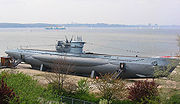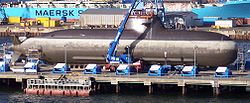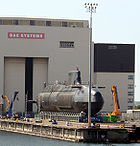
Teardrop hull
Encyclopedia



Submarine hull
The term light hull is used to describe the outer hull of a submarine, which houses the pressure hull, providing hydrodynamically efficient shape, but not holding pressure difference...
design which emphasizes hydrodynamic flow above all other factors. Benefits over previous types include increased underwater speed and a smaller acoustic signature
Acoustic signature
Acoustic signature is used to describe a combination of acoustic emissions of ships and submarines.-Contributing factors:The acoustic signature is made up of a number of individual elements...
, making detection by sonar
Sonar
Sonar is a technique that uses sound propagation to navigate, communicate with or detect other vessels...
more difficult. Another advantage was that the entire bow could be used to house a sonar for the submarine's own hunting of opponents; the foreplanes are located so as not to interfere with the sonar.
The design was initially introduced on USS Albacore
USS Albacore (AGSS-569)
USS Albacore was a unique research submarine that pioneered the American version of the teardrop hull form of modern submarines. The revolutionary design was derived from extensive hydrodynamic and wind tunnel testing, with an emphasis on underwater speed and maneuverability...
, and for this reason, is often referred to as an "Albacore hull." USS Barbel
USS Barbel (SS-580)
USS Barbel was the lead ship of her class of submarines in the United States Navy. She was the second Navy ship named for the barbel, a cyprinoid fish, commonly called a minnow or carp....
was the first operational submarine to feature this hull design, and some form of the design has been present in the operational submarine fleets of almost every navy since that time.
There are several design variations for specific purposes. American designers moved the foreplanes to the sail, where they could be tilted upward to aid in piercing thin ice in the Arctic Ocean; the British often located the foreplanes forward, at the level of the deck and enabled them to fold upward so as to not foul harbor structures; those of other countries often retract the foreplanes in ways conventional or novel. The hulls of Western submarines of this type end in a single propeller, so as to minimize drag; the Soviet equivalents often still had two propellers, to provide for a second motor either for greater power or safety. The Barbel hull had a long taper abaft of the sail, again to minimize drag, but the British Upholder class had the propeller axis depressed, with the extreme aft of the hull having a shorter taper, so as to provide greater strength to the hull. The German submarine pictured on this page has the aft of her hull tapering abruptly for this purpose, though its propeller axis follows that of the rest of the hull. The Albacore studied several positions of the afterplanes. American designers settled on a cruciform arrangement (a Greek cross viewed from behind); they rejected the alternative of an x-arrangement for its complexity, but it was accepted by the Dutch, among others, for its ability to snuggle closer to a shallow seabed without striking the rudder on the sea floor. The Soviets often repeated a conventional arrangement.

